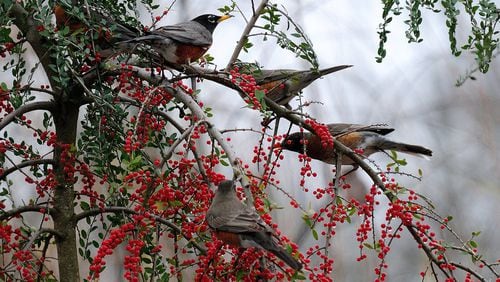The weeping yaupon holly is beyond stunning right now. No, the weeping plant wasn’t nuked or genetically modified to obtain that graceful appearance. It was found naturally and native and then simply propagated vegetatively by cutting.
Yaupons are native geographically in almost a third of North America. Botanically speaking they are Known as Ilex vomitoria with the weeping type known as Ilex vomitoria ‘Pendula.’ Native Americans made a tea out of the leaves which is still in practice by gardeners and herbalists in some Southeastern counties. In no way am I touting this and the species name vomitoria gives clear indication to the reason.
The weeping yaupon, however, is one of the best small trees to use in the landscape. When I lived in Rincon Ga., I had one as an accent at the corner of the home. At the Columbus Botanical Garden where I was the director, the back-patio area had one that was like a beautiful piece of sculpture welcoming all bridal parties. And recently I saw a pair at a McDonalds in Columbus, Ga., that were loaded with so many bright cherry-red-fruit, it was indescribable.
This winter all yaupon hollies seem to have the most dazzling berry crop I can ever remember. Who knows why perhaps it was just perfect pollination conditions. But a weeping yaupon with thousands of berries hanging downward in a cascading fashion is a joy more gardeners should experience.
Use them as an accent, a specimen or focal point or in a narrow garden. Think of it as a living piece of garden art. While I might suggest not overdoing it, I’m sure someone could ‘take me to school’ so to speak and demonstrate a world of possibilities.
The leaves are dark green serving as a good contrast with the whitish bark and brilliant red fruit. These berries not only give great winter color to the landscape but also provide a valuable source of food to more than a half dozen species of birds, like American robins, cedar waxwings, and the bobwhite quail.
The weeping yaupon can reach 30 feet in height, but most I have seen are 15 to 20 feet with a 6 to 12-foot spread. When choosing a site, remember that a lot of sun gives best berry production. Prepare a bed by incorporating three to four inches of organic matter along with 2 pounds of a 5-10-5 fertilizer per 100 square feet. When digging your planting hole keep in mind that wider is better, allowing for good root expansion and establishment. Complete the project by adding a good layer of mulch after planting.
Feed your holly about four weeks after transplanting with one pound of an 8-8-8 fertilizer per 100 square feet. Established plantings can be given this application in April and August. Yaupons do not like to dry out. If you have an abundance of berries, many will drop due to drying out, so give supplemental irrigation during long drought periods.
Weeping yaupon hollies are cold hardy from zones 7-9. If you are reading this in a colder area, I assure you there are other weeping trees to give your landscape that wow factor.
———
(Norman Winter, horticulturist, garden speaker and author of, “Tough-as-Nails Flowers for the South” and “Captivating Combinations: Color and Style in the Garden.” Follow him on Facebook @NormanWinterTheGardenGuy.)
About the Author






